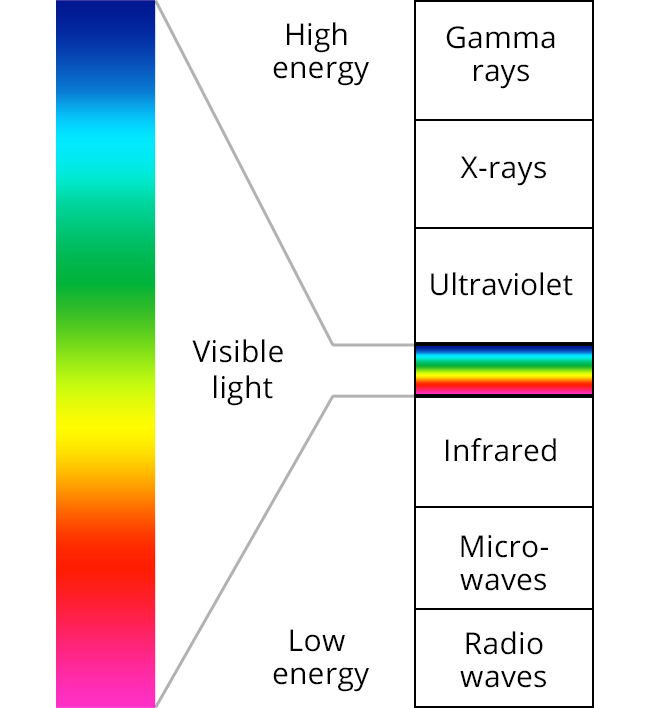
You probably know that too much exposure to the sun's ultraviolet (UV) rays can cause sunburn and skin cancer. But did you know UV can also harm your eyes? Extended exposure to the sun's UV rays has been linked to significant eye problems, including cataracts, macular degeneration, pingueculae, pterygia, and photokeratitis.
To protect your eyes from harmful solar radiation, it is important to wear sunglasses that block 100 percent UV whenever you are outdoors in daylight. This applies even on cloudy days since the sun's damaging UV rays can penetrate cloud cover. Sunglass frames with a close-fitting wraparound style provide the best protection because they limit how much sunlight reaches your eyes from all sides.
Understanding UV Radiation:

Ultraviolet (UV) rays are higher in energy and do not fall within the realm of visible light. UV radiation is invisible, and there are three categories of UV radiation:
1. UVC: These are the highest energy UV rays and potentially the most harmful to your eyes and skin. Fortunately, the atmosphere's ozone layer blocks virtually all UVC rays.
2. UVB: UVB rays have slightly longer wavelengths and lower energy than UVC rays. These rays are partially filtered by the ozone layer but still reach the Earth's surface. UVB rays can cause sunburn, skin discolorations, wrinkles, and other signs of premature aging. Overexposure to UVB radiation is also associated with eye problems such as pinguecula and pterygium.
3. UVA: UVA rays have lower energy than UVB and UVC rays. They can pass through the cornea and reach the lens and retina inside the eye. Overexposure to UVA radiation has been linked to the development of certain types of cataracts and may play a role in macular degeneration.
UV Risk Factors:
Anyone who spends time outdoors is at risk for eye problems from UV radiation. The actual dose of UV radiation you receive outdoors depends on several factors, including:
- Geographic location: UV exposure is greater in tropical areas near the Earth's equator. The farther you are from the equator, the smaller your risk.
- Altitude: UV exposure is greater at higher altitudes.
- Time of day: UV exposure is greater when the sun is high in the sky, typically from 10 a.m. to 2 p.m.
- Setting: UV exposure is generally greater in wide open spaces, especially when highly reflective surfaces like snow and sand are present. Urban settings with tall buildings offer more shade and less UV exposure.
- Medications: Certain medications can increase your body's sensitivity to UV radiation.
UV Protection Recommendations:

The UV Index is a measure of UV exposure risk. It predicts each day's ultraviolet radiation levels on a simple 1 to 11+ scale. Here are some recommendations based on the UV Index:
- Low (2 or less): Wear sunglasses. If you burn easily, use sunscreen with an SPF of 15+.
- Moderate (3-5): Wear sunglasses, cover up, use sunscreen, and stay in the shade near midday.
- High (6-7): Wear a hat and sunglasses, cover up, use sunscreen, and reduce time in the sun between 10 a.m. and 4 p.m.
- Very high (8-10): Wear a hat and sunglasses, cover up, use sunscreen, and minimize sun exposure between 10 a.m. and 4 p.m.
- Extreme (11+): Wear a hat and sunglasses, apply sunscreen liberally every two hours, and try to avoid sun exposure between 10 a.m. and 4 p.m.
Children Need UV Protection Too:
Children are more susceptible
to eye damage from UV rays because their lenses allow more UV to penetrate deep into the eye. It's crucial to protect their eyes with good quality sunglasses or photochromic lenses when they go outdoors. Encourage your child to wear a hat on sunny days for further protection.
Additional Tips:
- Not all sunglasses block 100 percent of UV rays. Get your sunglasses evaluated by your eye doctor to ensure proper UV protection.
- Wear sunglasses even in the shade, as UV rays can still reach your eyes from reflected surfaces.
- Sunglasses are important in winter too, as fresh snow can reflect 80 percent of UV rays.
- Even if your contact lenses block UV rays, you still need sunglasses to protect the delicate tissues around your eyes.
- Dark skin and eyes do not eliminate the need for sunglasses, as UV damage can still occur.
Enjoy sunny days safely by wearing the right sunglasses to shield your eyes from the sun's harmful UV rays. Your eyes and long-term vision health are worth protecting.

Post a Comment